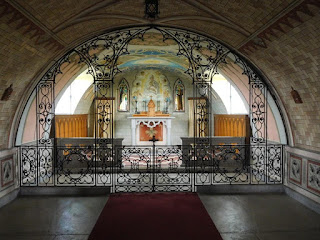Thursday early we took a taxi to the airport for our flight to Kirkwall. This small city of about 10,000, is one of the the largest in the Orkney Islands and is on the largest Island called by the residents the Mainland
 |
Waiting in Edinburgh airport for the flight to Kirkwall |
 |
This Saab 340 is rugged and can take off and land in strong winds, common in the Orkneys |
 |
The firth (estuary) of Forth - (I love saying that!) is a fjord bounded by Fife to the north (and Edinburgh/Lothian to the South) |
 |
This chapel was built by Italian prisoners of war. The facade hides that it is two Nissen (aka Quonset) huts end to end. |
 |
The inside is amazing and reflects true artistry |
 |
Kinlay Francis was our guide and was very personable and knowledgeable! The "brick" wall behind him is painted. You have to touch it to convince yourself it is not brick. |
 |
The metal for the communion rail and lattice work came from therailings from one of the barrier ships sunk nearby (more on the barrier ships in a bit) |
 |
The prisoners made very handsome items from scraps which they used to barter with the local folks for paint and other scarce items. |
 |
The entry and baptismal |
 |
This little heart hold the locking pin for the communion rail gate |
 |
This candle holder is made from ration tins! |
 |
The candelabra on the left is made from and old spent artillery shell casing while the one on the right is from the railing from the barrier ship |
 |
The Stations of the Cross are carved from wood scrounged by the prisoners - usually form crates and the like |
 |
This crucifix survives outside - when the last Italian left some months after the end of the war, he secured a promise from the locals that they would maintain the chapel |
 |
This piece of foundation is all that remains of the many barracks used to house the prisoners. |
 |
This statue of St George is made from reinforced concrete - barbed wire forming the reinforcement! |
 |
A family photo in front of the chapel |
 |
These coastal guns protected the entrance to Skapa Flow, one of the largest natural harbors in the world and home to the British Fleet during World War I |
 |
This view gives a little idea how big Skapa Flow is! |
 |
This green marker buoy marks the resting place of the HMS Ark Royal, lost with nearly all hands |
 |
We then drove to the other side of the island to see some sights that predate Stonehenge by several centuries! |
 |
The Standing Stones of Stenness have a henge (ditch) around them and no one is certain how they were used. |
 |
Many of the stones have been removed or destroyed by farmers who wanted to discourage people from walking through their land! It was windy and brisk the day we visited! |
 |
This nearby burial mound dates to 3 millennia BC! |
 |
Not too far away is Skar Brae - one of the oldest neolithic villages in the world. |
 |
This village sits on the North Sea but at one time, this bay is believed to have been closed off forming a loch (lake) |
 |
This reproduction shows what we will see in the village was like when it was occupied. |
 |
The fire pit surrounded by living area - much like a North American Teepee, only made form stone and underground |
 |
This gate leads to the site some 250 yards down a path . . . |
 |
. . . with markers along the way noting certain significant moments in history - right inside the gate are these two noting first man in space and the lunar landing |
 |
The fall of Rome |
 |
The Birth of Christ |
 |
The Temple of Solomon |
 |
Stonehenge (2100 BC) |
 |
The Pyramids of Giza (2500 BC) |
 |
Skara Brae (3100 BC!) |
 |
I'm glad we had the reproduction to help imagine what we are seeing. |
 |
This large bay is believed to have been a large fresh water lake. When it eroded away and became salt water, the village was probably abandoned |
 |
This display is one of many on the visitor's center that help tremendously to understand the complexity of the society that built this village - they even had central plumbing! |
 |
Back in Kirkwall, we checked into Mrs Delday's Lerona B&B and walked the short 5 blocks to this little pub for a nice dinner and a couple of pints! |












No comments:
Post a Comment